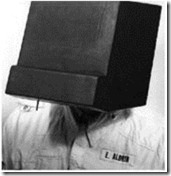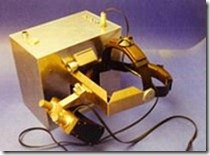Cosmic rays cannot turn a man into a rocky goliath or into a human torch, neither give a man invisibility or a stretching body. Nevertheless we must acknowledge Stan Lee’s intuition that cosmic rays could interact and have actual effects on human biology.
Before detailing what cosmic rays are and where they come from, I would like to introduce some effects they provoke and introduce the scientific rationale that’s behind ALTEA investigation.
During Apollo 12 mission (1969), there was an experiment called “the Apollo helmet dosimetry experiment”, during which the signs of cosmic ray passage on an astronaut helmet were very evident.
ALTEA studies the effects of cosmic rays on central nervous system and in particular the Light Flash phenomenon. Currently light flashes are the only way that humans have to actually see elementary particles without any instrument or detector. In 1952 the physicist Cornelius Tobias predicted that cosmic rays could interact with astronaut visual system to generate anomalous perceptions of light (without the effective presence of light) . In 1969, during Apollo 11 mission, Buzz Aldrin reported the first experience of these flashes after their eyes had become adapted to the low light in the cabin. He talked about strange flashed of multiple shapes and dimensions.
After this first report, the astronauts of the following lunar missions were informed about the phenomenon and started dedicated observations. During the last lunar missions, Apollo 16 and 17, the ALFMED emulsion detector studies the correlation between the light flash perceptions and the cosmic rays.
ALFMED results showed that high energy charged particles composing cosmic rays were the effective cause of the light flashes. The interaction mechanism remained unexplained. Systematic studies on Light Flashes were carried on during the Skylab (1974) and the Apollo-Soyuz (1975) missions. In the meantime some scientist volunteered to expose themselves to low intensity particle beams to study the phenomenon in controlled conditions. Light Flashes could be reproduced by various particles passing through the eyes.
Light Flashes are highly subjective: some astronauts are particularly sensitive and can observe the phenomenon even in bright environment while others never observed any. Some astronauts are so annoyed by these flashes that cannot fell asleep. There are different shapes of flashes: stripes, multiple tracks, stars, explosions, etc..
When it’s time to link the LF phenomenon to the physics mechanisms originating them a lot of problems arise. It is needed to correlate observations from electronic detectors with astronaut sensations. The importance of these studies is given by the fact that LF could be symptoms of a wider family of more complex neuro-physiologic effects that are still hidden.
Studies on LF continued during the 90’s onboard MIR space station with the Sileye project. In the frame of this project almost 50 observation sessions were completed between 1996 and 2000 by 10 astronauts that observed more than 200 LFs. Sileye derives its name from Silicon Eye, the particle detector coupled with an helmet used for the observations. The cosmonaut wears the helmet in a dark environment and pushes a button whenever he observes a flash; in the meanwhile the particle detector measures the energy of all nuclei passing through it.
Sileye program continued on ISS with the Alteino-Sileye3 detector, that is the link between the Sileye project and the ALTEA program. Alteino was brought onboard the International Space Station during Marco Polo Mission in 2002. First measurements were carried on by the Italian astronaut Roberto Vittori. Alteino device returned back to Earth in 2010.
Coming soon: Radiation environment in Earth orbit.
Previous posts:
Cosmic rays and human exploration of space
ALTEA- An Italian experiment onboard the International Space Station
Further readings and sources:
Cosa sono i Light Flash (in Italian)
Light flashes (in Italian)
How can astronauts see stars with their eyes shut









